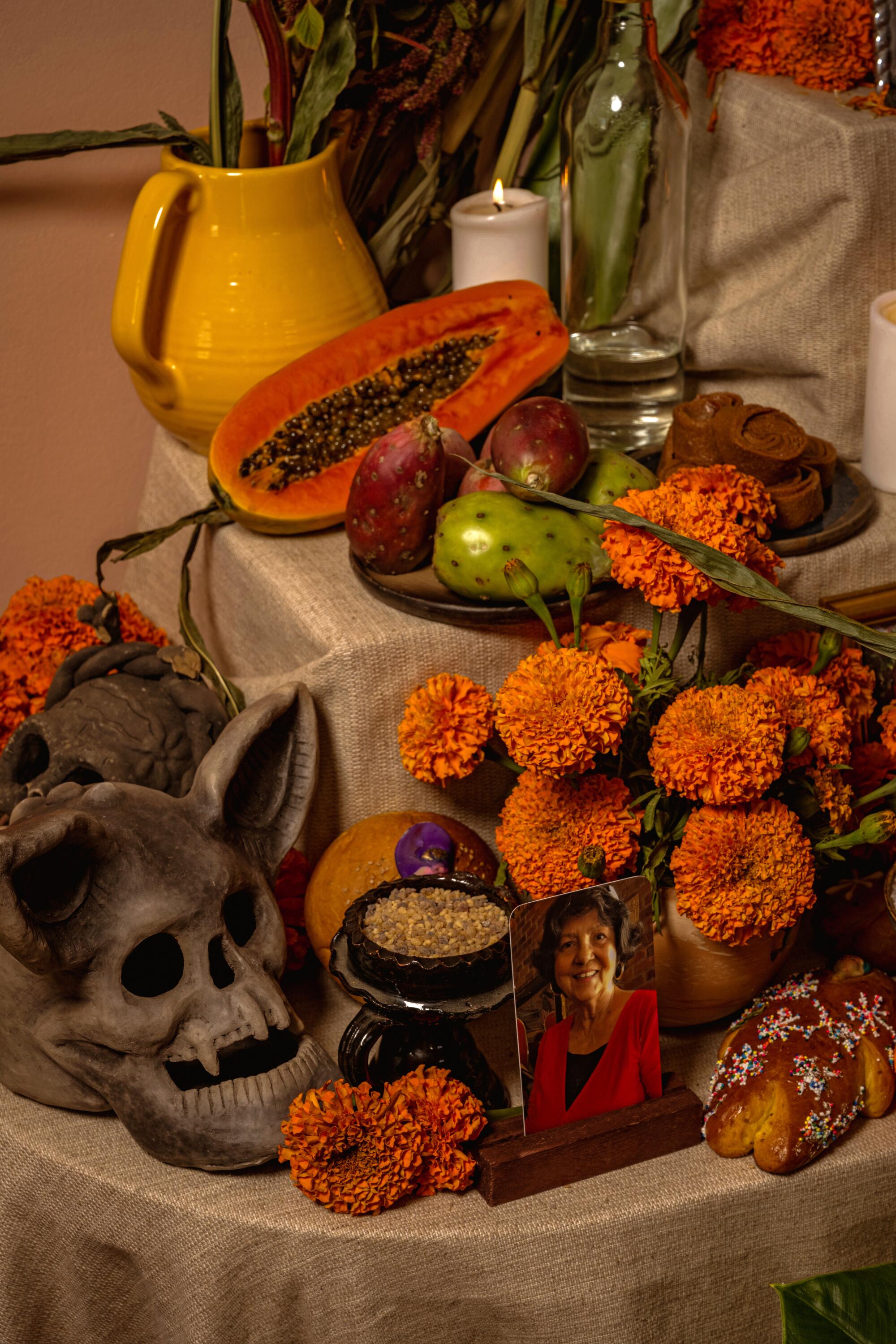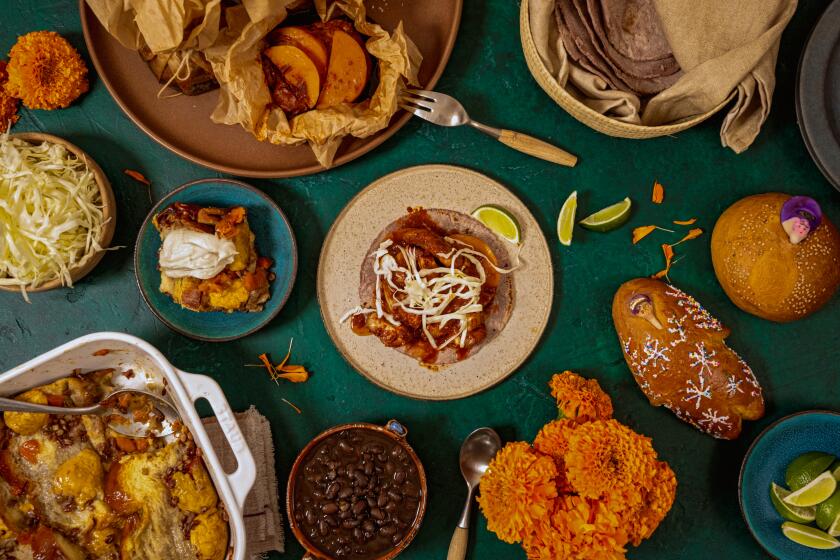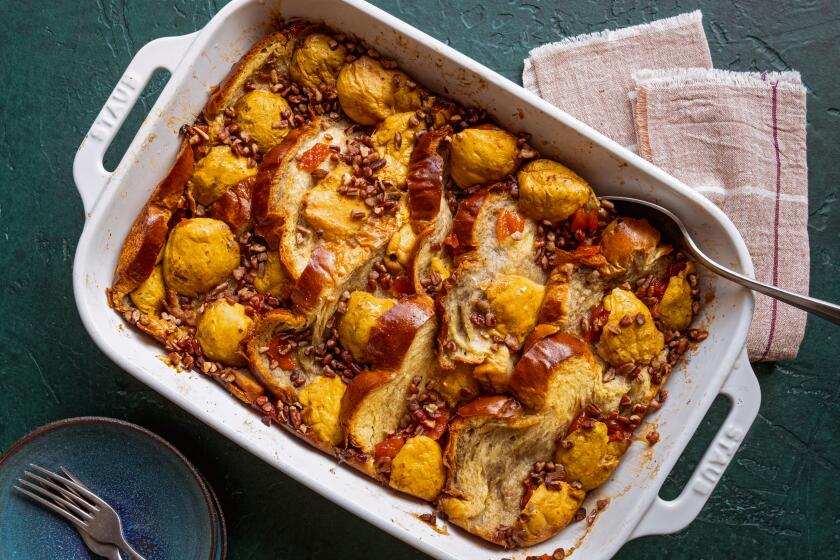
- Share via
It wasn’t until I moved to Los Angeles and saw people from all over Mexico honoring their dead that I built my first Día de Muertos altar 13 years ago. Now, it is an annual rite I practice every Nov. 1 and 2.
I’ve witnessed how a spiritual ritual I grew up celebrating — by scrubbing graves in my town in Mexico and adorning them with flowers and my loved one’s favorite foods — has transformed into a cultural event and tradition for all Angelenos. I even played a part in the phenomenon through my role as the producer of one of the largest Day of the Dead festivals in the U.S. at the Hollywood Forever Cemetery between 2013 and 2023. The celebration that’s remained alive for centuries has grown around the world and in Mexico itself continues to evolve.
For Día de Muertos, make these mixiotes of chile-marinated chicken cooked in bundles of string-tied parchment. Add a dessert of bread pudding soaked in piloncillo syrup and studded with fruit and pecans.
In Mexico City, there is now a giant Day of the Dead parade, said to have been inspired by the opening scene in the 007 movie “Spectre.” In Oaxaca and Michoacán, the holiday has become the peak of the tourist season after the commercialization of this tradition via movies like Pixar’s “Coco.”
While it’s easy to get turned off by the commercialization of this spiritual practice, Mexican and Indigenous immigrants know that Día de Muertos is not just another day to dress up in costume. It’s not the new Halloween. It’s a chance for many to reclaim Mexico’s Indigenous roots.

The celebration goes back to pre-Hispanic times when it was believed the dead come back to visit the living. Merging Catholic traditions imposed by the Spanish conquistadors with cultural practices in place long before colonization, it stands as a testament to the resistance and identity of Indigenous communities. In 2003, UNESCO recognized the Día de Muertos celebration as an Intangible Cultural Heritage of Humanity.
Creating an altar has become a collective expression of grief and love.
Many here in the U.S. and across the Mexican diaspora are unable to go back to Mexico to be with their loved ones as they take their last breath. Being separated from our families and living with the imminent fear that we might be too far away if life comes to an end gives Muertos a beautiful and timeless sentiment about sharing our culture and our humanity.
Muertos helps us to reconnect. It brings us closer.

When to build your ofrenda
Honoring the ancestors is universal. Anyone called to commemorate their loved ones can embrace and celebrate Día de Muertos.
All across Mexico, from Michoacán to Oaxaca, each region has a different way of honoring the departed. In many places, altars begin forming on or around Oct. 27, when it’s believed that animals are the first to visit as they guide souls on the long journey back to this plane.
According to tradition, the spirits start their trip to the world of the living on Oct. 28, with those who unexpectedly left us arriving first. On Nov. 1, the spirits of children return. The celebration on Nov. 2 includes everyone who died in adulthood.
An easy chicken recipe for Día de Muertos: These parcels of chile-marinated chicken are wrapped in string-tied parchment bundles and steamed with sliced fall squash, for serving with tortillas, cabbage and wedges of lime.
In addition to the altars, it’s customary to visit the graves of loved ones, clean them and decorate them to honor their lives. An ofrenda is built on top of the grave, filled with flowers, food and pictures. You can hear music and live bands blaring throughout the day and into the night across cemeteries all over Mexico.
Altars are taken down on Nov. 3 when the celebration ends.

A step-by-step for your altar
Each altar is unique, and it can be a collective ofrenda, honoring more than one person. It can include some symbols of the traditional altars built in Mexico, but it can be as modest or elaborate as you’d like.
Sizes of altars vary based on their significance, ranging from two to seven tiers representing the levels the soul must traverse to reach its final resting place. However, one of the most common configurations is the three-level altar.
You can use any table as the base and add smaller boxes, crates or even books to easily create multiple levels. The altar can be draped with a zarape or tablecloth to cover the base and create a smooth surface to set up the ofrenda.
A petate, a traditional woven mat made from dried palm leaves or grass, holds cultural significance in Mexico and Central America and is often used in ceremonies and rituals. A petate is used to delineate the altar space and to symbolize comfort, rest and home. Find your petate at L.A. Oaxaca Express at 1124-B S. Western Ave. They come in different sizes priced at $13 to $25.
The archway, sometimes created with a variety of materials — such as flowers, sugar cane or corn — signifies a doorway for souls to find their way to us. You can find fresh and dried corn stalks for $5 each at Oregon Coastal Flowers, stall No. 27 inside the Original Los Angeles Flower Market in downtown L.A.
Level by level
The ofrenda adds a spiritual dimension to the altar, adorned with flowers, photos, food, beverages and items that honor the memory of loved ones.
The first level: You can create a path with cempasúchil, also known as Mexican marigold, a flower native to southeastern Mexico that is said to guide the spirits back home with its citrusy and intoxicating herbal scent. Visit the Original Los Angeles Flower Market for the city’s best selection of local and imported flowers. A bunch of marigolds with a few stems of the orange bloom runs about $3 to $5 each, or a bundle (also ordered as a “bucket”) containing 12 bunches with enough flowers to fill a simple but modest altar comes to $42 inside the flower market at O&J Growers on 755 Wall St., Unit 3.
Another flower often seen on altars is the cockscomb, also known as Celosia argentea or cresta de gallo, a striking flower characterized by its unique velvety texture and plume-like shape that resembles a rooster’s comb.

Baby’s breath, or nube, can be used to symbolize sacredness, joy and life. Find it at the downtown flower market too.
If you have a handy portable cart, bring it to haul your bundles; even better, bring small buckets to keep your flowers hydrated to last longer. The flower market opens at 5 a.m., but many vendors start packing out at 10 a.m. Get there in the early morning hours to get the best selection. You can also buy flowers from the vendors on street corners all around Los Angeles. Street vendors are always there for you.
One of the last key elements for the altar’s first level is salt, a symbol to ensure the soul’s purity, helping it to not get lost on the journey to and from the afterlife.
Lastly, the scent of Día de Muertos: copal. The Bursera bipinnata tree resin is earthy with undertones of frankincense and a hint of sweetness. Its aroma and smoke are said to transverse and communicate between the material world and the world of spirits. Find copal in resin rocks or in incense form at most Mexican health markets also known as herbolarias such as Herbs of Mexico at 3903 Whittier Blvd. Online at Relato Nativo, find copal harvested responsibly in the mountains of the Southern Sierra Madre of Oaxaca.

The second level: You typically add candles (they can also go on the other two levels). Their purpose is to light the way for our loved ones during their visit. This is where you will also include offerings of their favorite foods such as the traditional mole and other dishes, sweets and snacks. Fruits such as tunas (prickly pears), guavas and plantains and beverages such as mezcal or their favorite libations all bring joy to the altar that connects us to our loved ones. Most of these items are available at Mexican supermarkets like Northgate Gonzalez Markets and your local neighborhood mercado or tiendita.
This luscious bread pudding recipe is made with a spiced syrup rather than a custard, studded with fresh guava, dried apricots and toasted nuts.
Pan de muerto, the baked sweet bread decorated with bones and skulls, also known as Day of the Dead bread, is added to represent the spirit being honored. Sinecio Mecinas paints colorful caritas (faces) etched on dried corn masa and bakes them onto egg-yolk enriched dough at his bakery, La Yalaltequita, at 8693 Venice Blvd.
Mecinas makes this regional style of Oaxacan pan de muerto in which ornate designs are painted on the bread by hand. For pan de muerto that adds a new dimension of sourdough flavor to perhaps Mexico’s most beloved seasonal pan dulce, Gusto Bread at 2710 E. 4th St. in Long Beach makes it with a wild fermented dough lightly perfumed with toasted fennel and orange zest, topped with the symbolic “skull and bones” dusted in vanilla and rose sugar.
Leave a glass or a jar of water so the spirits can refresh after their long journey home.
The third level: Place the photo of the person to whom the altar is dedicated at the top, framing it in the middle of the arch. You can fill the rest of the altar with photos of all the loved ones if creating a community altar. Other objects to add to your ofrenda are your loved ones’ most treasured belongings. Also, sugar or clay skulls: They tell us that death is always present in life, reminding us how to live.
Building an altar and celebrating a loved one transcends life and death. There is no wrong way to do it. Gather around the altar, turn up the music — usually the kind your loved one enjoyed in life — and feast and drink to nourish both the living and the spirits.
“Nuestro culto a la muerte es el culto a la vida.” Our worship of death is the worship of life, says Mexican poet Octavio Paz.
Ya se siente el frío de los muertos.

More to Read
Eat your way across L.A.
Get our weekly Tasting Notes newsletter for reviews, news and more.
You may occasionally receive promotional content from the Los Angeles Times.













